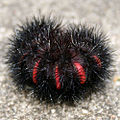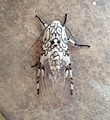Giant leopard moth
| Giant leopard moth | |
|---|---|

| |
| Scientific classification | |
| Kingdom: | |
| Phylum: | |
| Class: | |
| Order: | |
| Family: | |
| Tribe: | |
| Genus: | |
| Species: | H. scribonia
|
| Binomial name | |
| Hypercompe scribonia (Stoll, 1790)
| |
| Subspecies | |
| |
| Synonyms | |
| |
The giant leopard moth or eyed tiger moth (Hypercompe scribonia) is a moth of the family Arctiidae. It is distributed throughout the Americas from southern Ontario, and southern and eastern United States through New England, Mexico and up to Colombia.[2] The obsolete name Ecpantheria scribonia is still occasionally encountered.
This species has a wingspan of 76 mm (3 in). The wings of this moth are bright white with a pattern of neat black blotches, some solid and some hollow. The overside of the abdomen is dark blue with orange markings while the underside is white with solid black spots, the male has a narrow yellow line on the sides. Its legs have black and white bands. Adult moths are strictly nocturnal and do not generally fly before nightfall.[3]
This species has a notable sexual dimorphism in size, the adult male reaching about 51 mm (2 in) in length while the adult female grows up to 30 mm (1.2 in). During mating sessions, the wings of the male cover most of the female's abdomen, this can sometimes lead up to loss of wing scales in the female, which can have negative effects on its flight efficiency.[4] Their mating sessions are notably long-lasting, taking more than a 24-hour period, they stay mostly immobile during the whole process, but will move from spot to spot in order to thermoregulate, walking into shadowy areas if it's too hot or into sunlight if it's too cold. The male is the one that effectuates the locomotion, while the female folds its legs in order to be easier to carry.
The caterpillar is of the "Woolly Bear" kind, with a thick coat of black bristles (setae) and red or orange colored bands between its segments, which become conspicuous when the caterpillar rolls into a ball for defense. Like the banded wooly bear, its hairs are not urticant, and do not typically cause irritation.
Recorded food plants
The caterpillar eats a variety of broad-leaf plants such as broadleaf plantains, dandelions and violets:
|
|
Gallery
-
Larval stage
-
Caterpillar in typical defensive ball
-
Caterpillar with typical red stripes
-
head of a caterpillar
-
Closeup of head and thorax
-
Closeup showing iridescent blue spots
-
Closeup of newly eclosed moth
-
Showing the old skin, empty pupal shell, and adult moth
-
Last image at night before it flew off once wings dried
-
Wings spread, displaying abdomen colors
-
Close-up while wings upswept
-
The moment before take-off
-
A female giant leopard moth after mating.
References
- ^ Poole, Robert W.; Patricia Gentili (1996). "Hypercompe scribonia". NatureServe. Retrieved 18 July 2013.
- ^ Hypercompe scribonia, Butterflies and moths of North America
- ^ Fullard, James H. & Napoleone, Nadia (2001). Diel flight periodicity and the evolution of auditory defences in the Macrolepidoptera. Animal Behaviour 62(2): 349–368. doi:10.1006/anbe.2001.1753 PDF fulltext
- ^ [1], Scoble, M.J. (2005). The Lepidoptera: Form, Function, and Diversity. Page 63. Accessed through Google books on 21 Aug 2009














